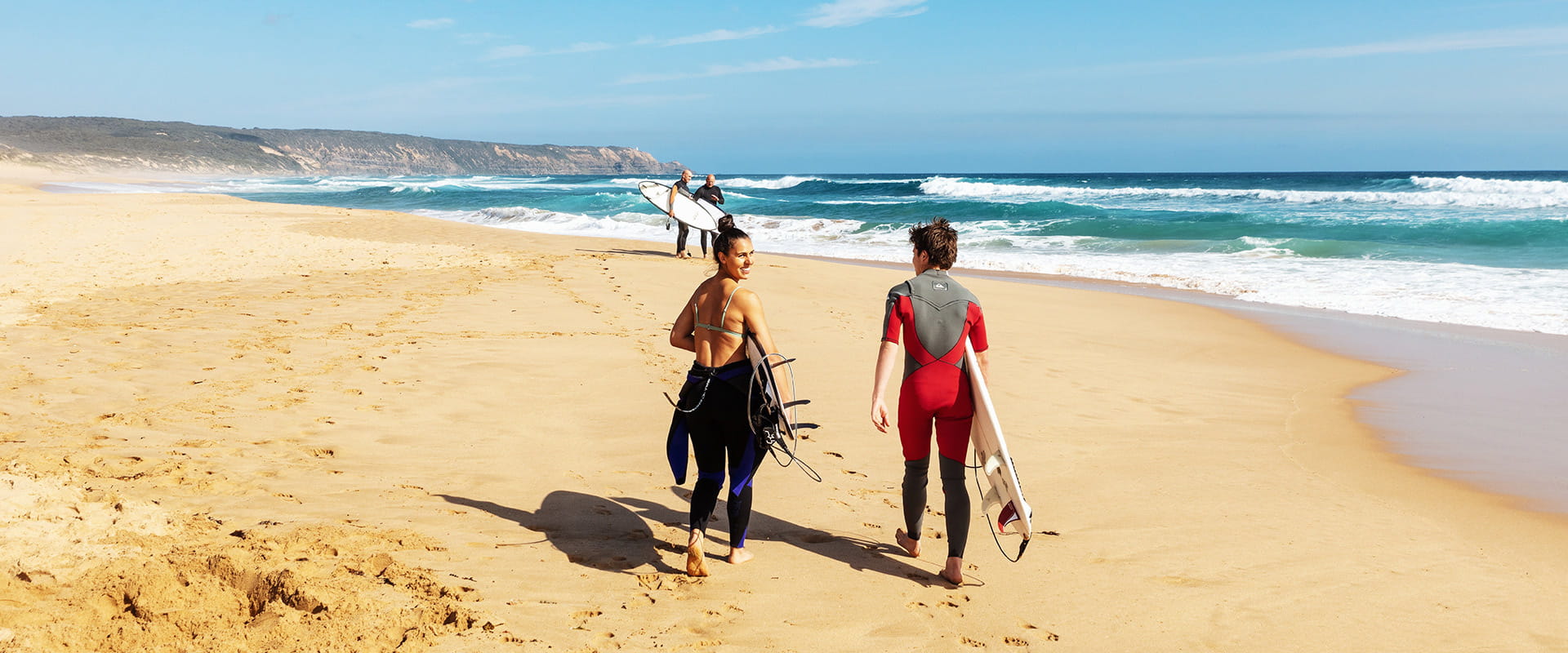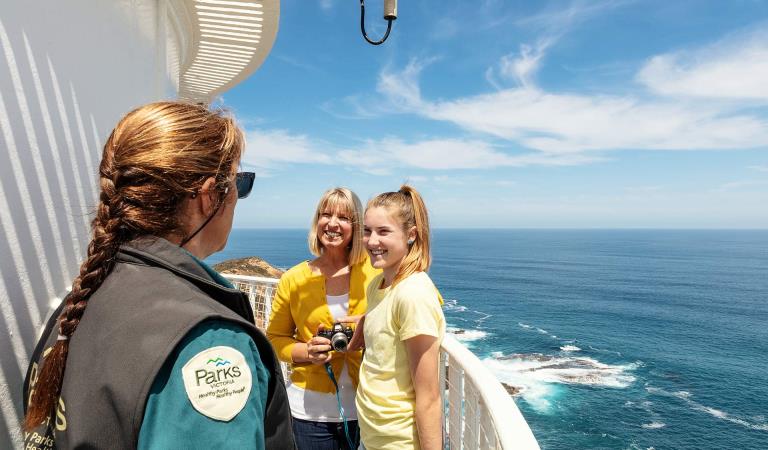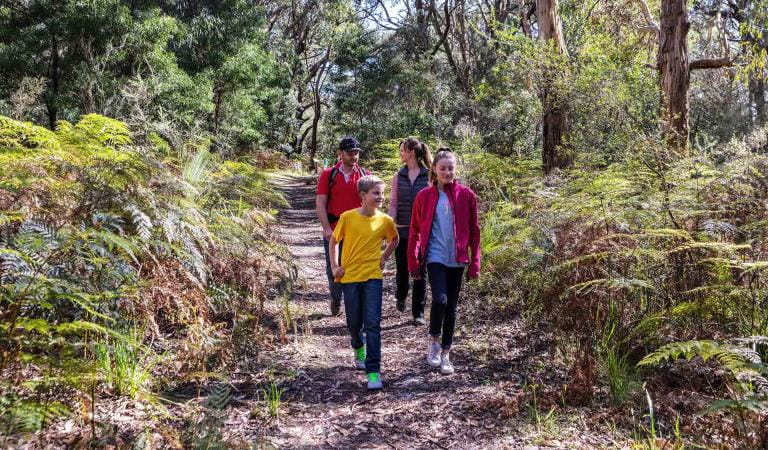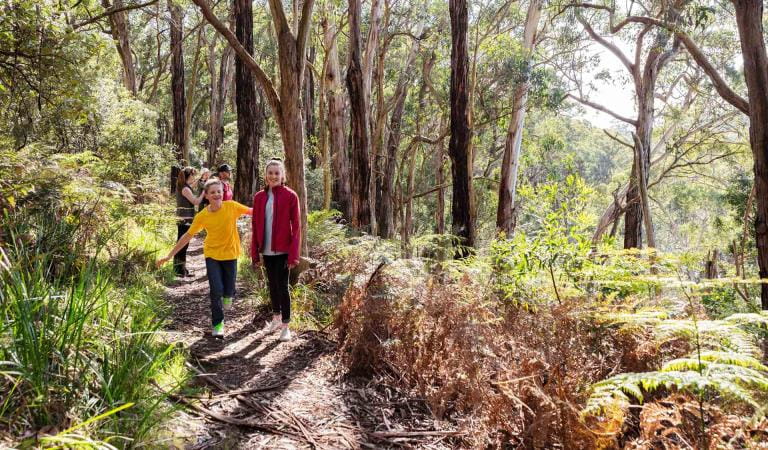Dip into the excellent surf beaches of the Mornington Peninsula National Park. Tackle the waves of Gunnamatta, Flinders, Portsea and Rye ocean beaches.
Portsea, Sorrento and Gunnamatta surf beaches are patrolled during summer holidays.
The Cape Schanck Lighthouse has been guiding ships along this treacherous coastline since 1859. Visit the lighthouse museum, join a tour and enjoy dramatic views over the Bass Strait.
Step out on The Coastal Walk for spectacular coastal views. The two-day walk meanders along high clifftops, through coastal vegetation and past stunning ocean beaches.
The sandy shore of Flinders Beach merges with the sandstone rock platforms of Mushroom Reef Marine Sanctuary, the perfect location for a snorkel or scuba dive - and a great place to see a Weedy Seadragon.
The spectacular amphitheatre-like setting of Sorrento Ocean Beach makes it a perfect spot for beachcombing. Explore the rockpools, some of which are large enough to swim in.
The Two Bays Trail snakes through Greens Bush across the Mornington Peninsula, from Dromana on Port Phillip to Cape Schanck in Bushrangers Bay.
A haven for native wildlife such as kangaroos, Greens Bush is the largest fragment of native bushland remaining on the Mornington Peninsula.
Explore the weathered sandstone formations of London Bridge and take in the vistas over Bass Strait from the lookout. Bring your snorkel and dive in to discover the rich marine life of the area or sit back and relax on the sandy beach.
Escape to the sheltered cove of Bridgewater Bay. Explore the rockpools, relax on the sandy beach and take in the views of Bass Strait.
Dogs are not permitted in Mornington Peninsula National Park. This includes beaches, carparks and Greens Bush.
Things To Do
Sorrento Back Beach
Sorrento Back Beach is located around 1.5km south of the town of Sorrento. The beach is a popular location for activities such as surfing, swimming, walking and exploring the rockpools at low tide.
The beach is patrolled on summer weekends and holidays. Please swim between the flags as ocean beaches are dangerous for swimming.
Facilities at the site include a large car park and picnic area with toilets. A café and kiosk is available year round and also caters for functions and weddings.
A short 0.5km circuit track from the lifesaving club to the lookout rotunda provides excellent views along the coast. Add 1.2km loop to Sphinx Rock.
Coppins track, which starts at the kiosk, is a three kilometre guided historic walk that winds along the cliff tops to Diamond Bay tracing the history of the area over the last 100 years. The track follows sections of the original 1800s limestone paved footpath.
Portsea Ocean Beach
This popular beach is a great location to explore the national park’s wide sandy beaches and naturally weathered cliffs.
Popular activities include surfing, swimming, walking and ocean fishing. The beach is patrolled during summer and school holidays. Refer to regulations and only swim between the flags.
Facilities include four large car parks with two toilet blocks, including an observation car park with lookouts and spectacular views of the coast.
Food is often available at a kiosk at the surf lifesaving club during summer holiday periods.
Koonya Ocean Beach
This open sandy beach is popular for surfing, fishing and sunbathing.
Facilities include two car parks, a lookout and a toilet block at the end of Hughes Road. The beach is accessible via stairs and a steep ramp.
Swimming is not advised as the beach is unpatrolled and can be hazardous due to large waves, strong currents and submerged rocky reefs.
Gunnamatta Ocean Beach
Gunnamatta Ocean Beach is the most popular surf beach in Mornington Peninsula National Park, with consistently high swells and rocky reefs.
This long stretch of exposed sandy beach is also popular with walkers who can follow the beach east towards Fingal and Cape Schanck, and west towards Boag Rocks. Ocean fishing is another common acitivity due to the many deep rip holes, gutters and rocky reefs.
Facilities include two large car parks and two toilet blocks, accessed via Truemans Road.
The beach is patrolled during summer and school holidays. Refer to regulations and only swim between the flags.
Rye Ocean Beach
Rye Ocean Beach is a popular surfing beach due to numerous reef breaks along the long stretch of exposed sandy coast.
Other popular activities include fishing and walking. Swimming is not advised at this unpatrolled beach as conditions can be hazardous due to large waves, strong currents and submerged rocky reefs.
Access to the beach is via a large car park and toilet block at the end of Sandy Road. The eastern end can also be accessed from walking tracks through the dunes at Ocean Drive, St Andrews.
Flinders Ocean Beach
A white sandy beach contrasted by the nearby basalt cliffs and rugged coast beyond.
A favourite family pastime is exploring the amazing rock pools of Mushroom Reef Marine Sanctuary. At low tide, the ocean withdraws to expose a huge mushroom-shaped rock platform extending from the beach. The reef is formed from ancient basalt and is famous for the diversity of marine life which make it their home.
Diving and snorkeling are popular activities on the subtidal reefs but take care of strong currents on this unpatrolled beach.
A hang gliding ramp is available on the cliff top above Mushroom Reef.
This popular beach is easily accessible from a car park off Golf Links Road, Flinders.
Cape Schanck
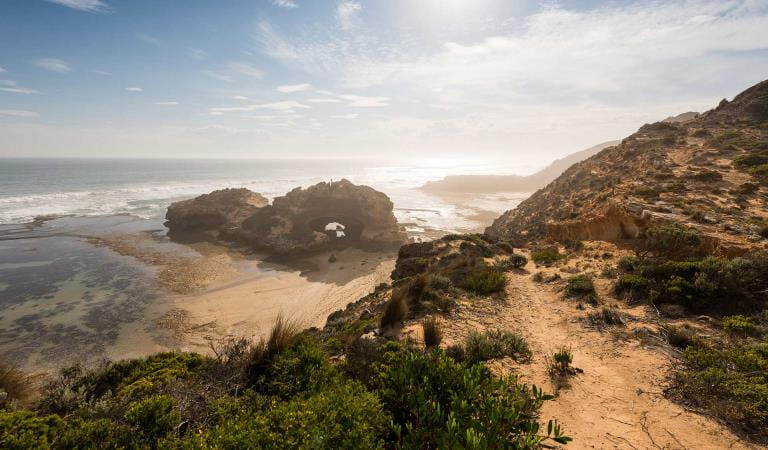
London Bridge
Greens Bush
Lightwood Creek Campground
How to get there
Ocean Beaches
Need to know
Ocean Beaches
Accessibility
The Sorrento Ocean Beach is the best place to gain access to the beach in the Mornington Peninsula National Park. There are views over Bass Strait from the carpark and cafe.
This is a good place for a longer stay or a full day trip.
Next to the kiosk is a short (40 metre) access ramp to the beach. Its slope is approximately 1 in 12 for the first 14 metres then 1 in 14 for the remainder. The ramp ends with the soft fine sand of the beach.
The changing rooms contain one accessible unisex cubicle.
There is good maneuvering room within the cubicle and bars at the side and rear of the toilet. There is space beside the toilet for a wheelchair. The flush is operated by two large recessed buttons on the rear wall just above the grab rail. The hand basin has clear space beneath it and no exposed hot water pipes. The internal door lock is a rotating type with wing handle.
Change of Conditions
Nature being nature, sometimes conditions can change at short notice. It’s a good idea to check this page ahead of your visit for any updates.
-
Flinders Ocean Beach (Mushroom Reef Marine Sanctuary, Mornington Peninsula National Park)
Mushroom Reef Toilet Closure Finders Ocean Beach
The toilet at Flinders Ocean Beach, Mushroom Reef is permanently closed. The nearest alternative public toilets are Flinders town centre public toilets.Landslip affecting beach west of Mushroom Reef, Flinders Ocean Beach
There is a landslip affecting the beach west of Mushroom Reef, Flinders Ocean Beach (within Mornington Peninsula NP). Please do not approach the slip.
-
Notices Affecting Multiple Sites
Fox Control Underway
Parks Victoria are undertaking fox control in Mornington Peninsula National Park from Portsea Ocean Beach to Greens Bush to relieve predation of vulnerable and threatened native fauna.Programs involve the use of cage and soft jaw leg hold traps, Canid Pest Ejectors with para-aminopropiophenone (PAPP) poison and buried PAPP poison, to bait foxes in strategic locations. Short track sections may be closed to isolate works (secondary tracks only).Fox trapping and baiting will occur until October 2026.Dogs are prohibited from entering Mornington Peninsula National Park. If pets are suspected of having consumed a PAPP bait during the baiting period, a vet should be consulted immediately. An antidote to PAPP (methylene blue) is available and stocked by many vets on the Mornington Peninsula.
Hooded Plovers
The Plovers lay their eggs directly onto the sand between the high-tide mark and the foredune. You can help their plight by avoiding the soft sand near the dunes and keeping away from nest sites. Dogs are not permitted.


